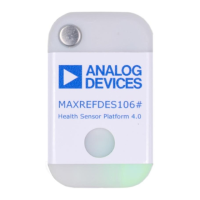©2023 Analog Devices, Inc. All rights reserved.
MAXREFDES106# Health Sensor Platform 4.0
Available Options
Table 6. PPG Measurement Configuration Options
Enables the measurement block. Each measurement block
can contain a unique LED+PD configuration, and up to nine
can be enabled per frame. A measurement can be thought of
as an exposure in a traditional camera.
Sets the width of the measurement block in micro- seconds.
This effectively modulates the optical-channel bandwidth,
allowing for a tradeoff between the LED power consumption
and PPG signal quality.
This sets the number of consecutive measurement blocks
that are collected and then averaged together into one
output. Refer to the MAX86176 data sheet for more
information on Burst Averaging.
Sets the full-scale range of the optical-signal path for the
PPG1 channel in µA.
Sets the full-scale range of the optical-signal path for the
PPG2 channel in µA.
Selects the photodiode (input pin) to sample for each PPG
channel. See Figure 55 for PD layout.
Sets the settling time for the photodiode(s) in µs. This is the
settling time that occurs after an ambient exposure sample
has completed and before the LEDs are driven for the next
exposure. Refer to the MAX86176 data sheet for more
details.
Sets the maximum current pulse amplitude for the LED
drivers in mA.
Sets the settling time for the LED(s) in µs. This is the settling
time that occurs before the PD can start sampling. Refer to
the MAX86176 data sheet for more details.
Selects the LED to drive for driver A/B. The configuration of
LED driver and LED mux are highly flexible, allowing for any
of the six LED driver pins to sink current from one or both
LED drivers. For MAXREFDES106/HSP4.0, the LEDs are
connected to the following DRV pins:
LED1 = IR
LED2 = Red
Sets the LED driver current pulse amplitude in mA. This is
the amount of current the driver pushes through the LED

